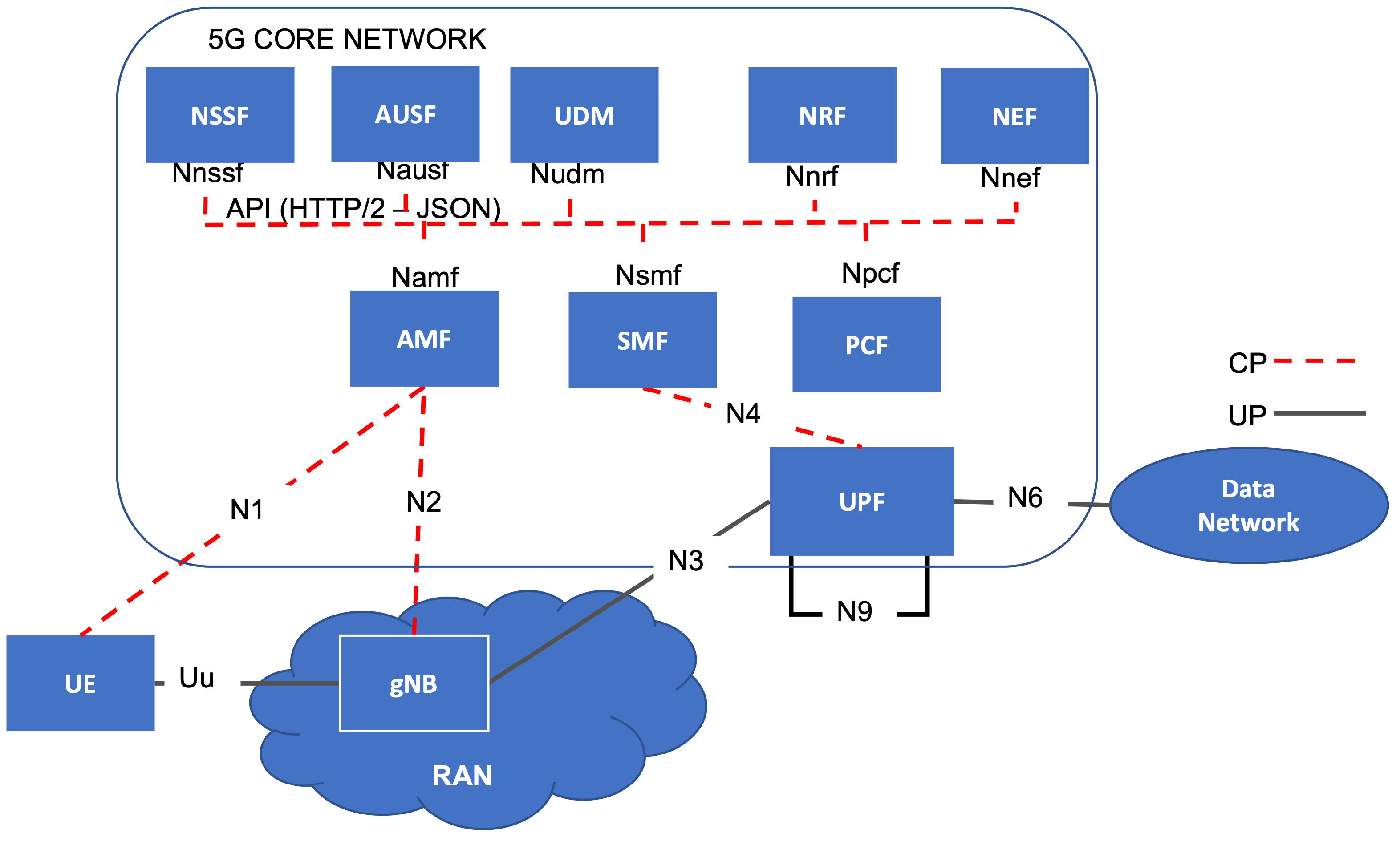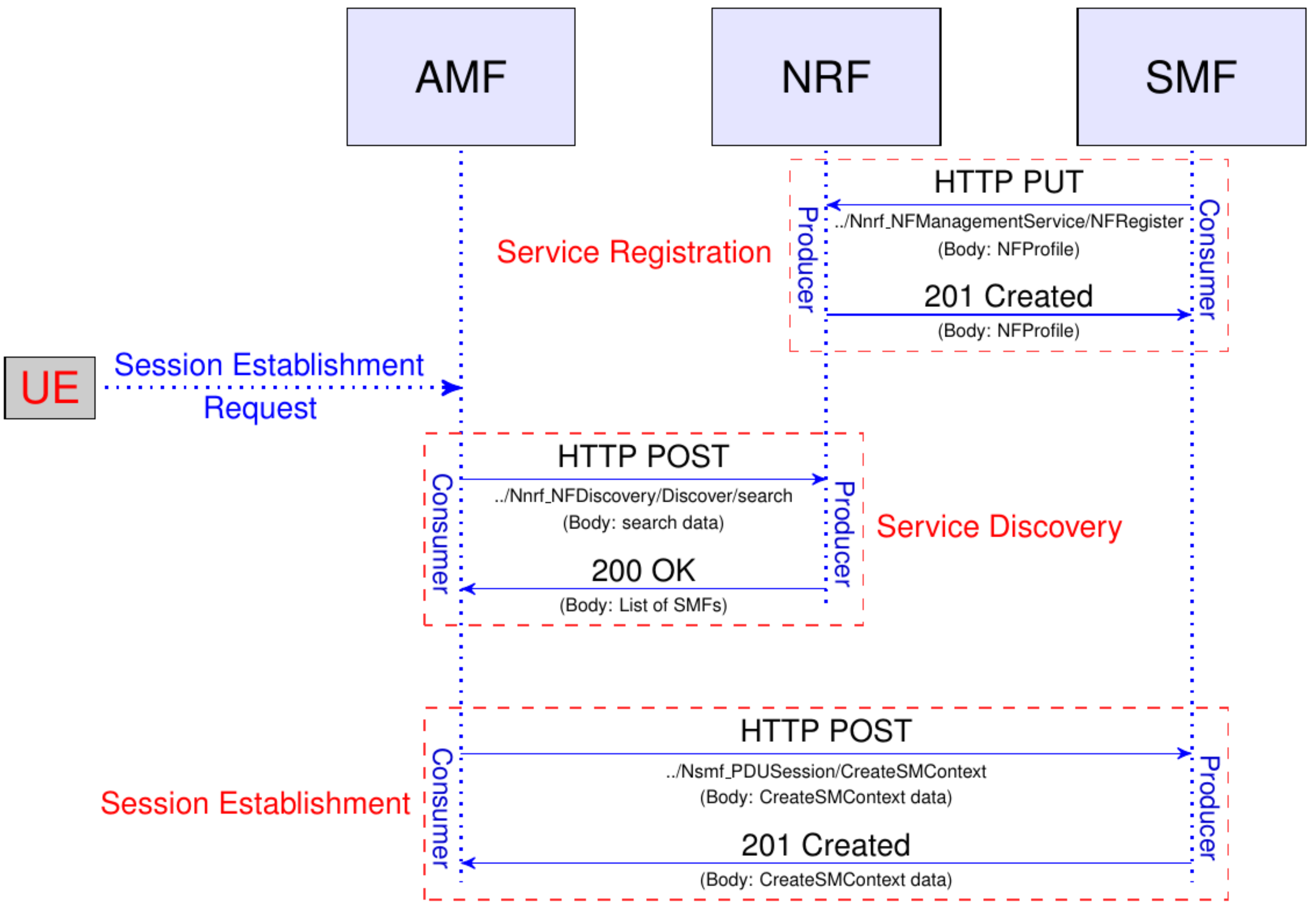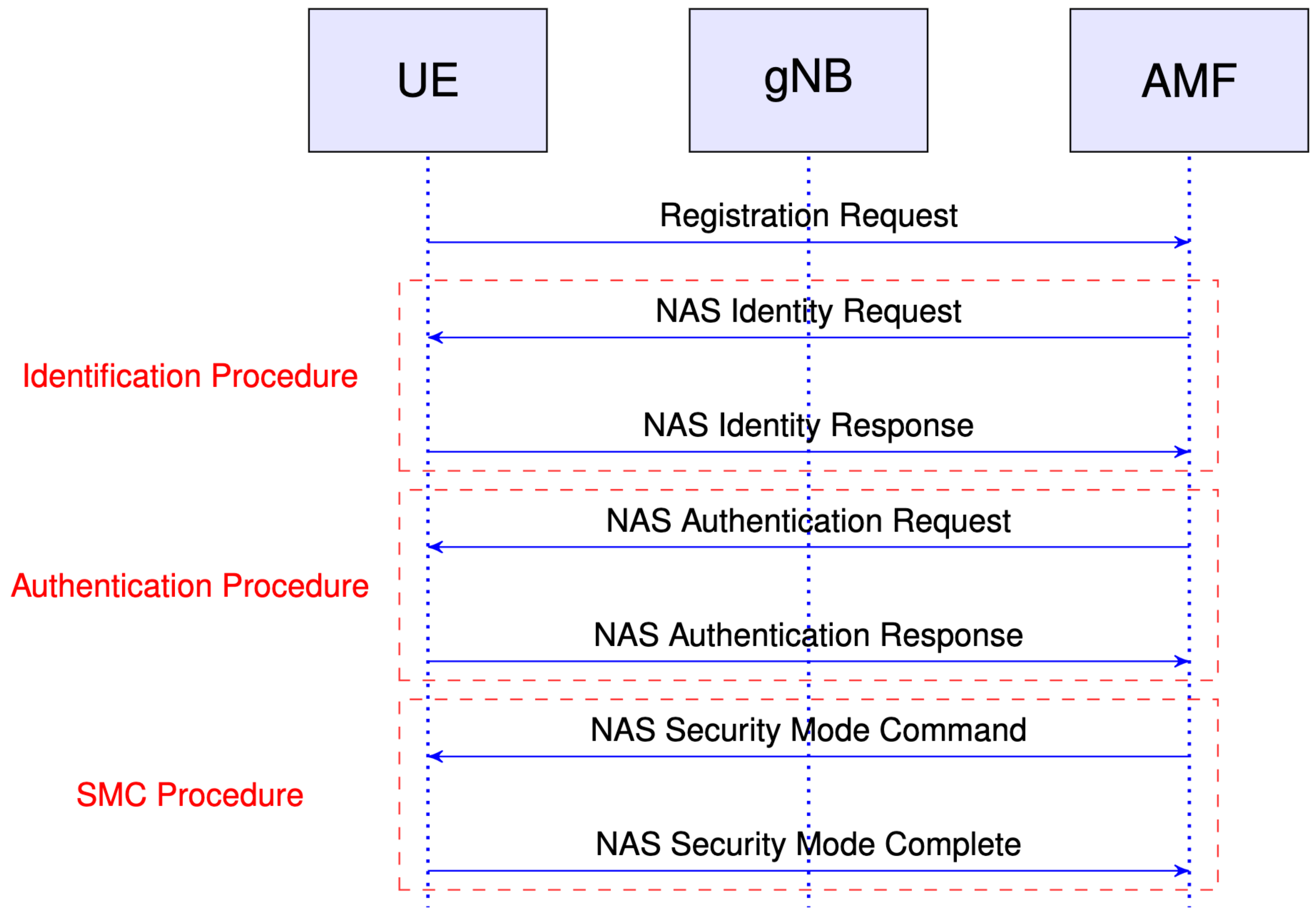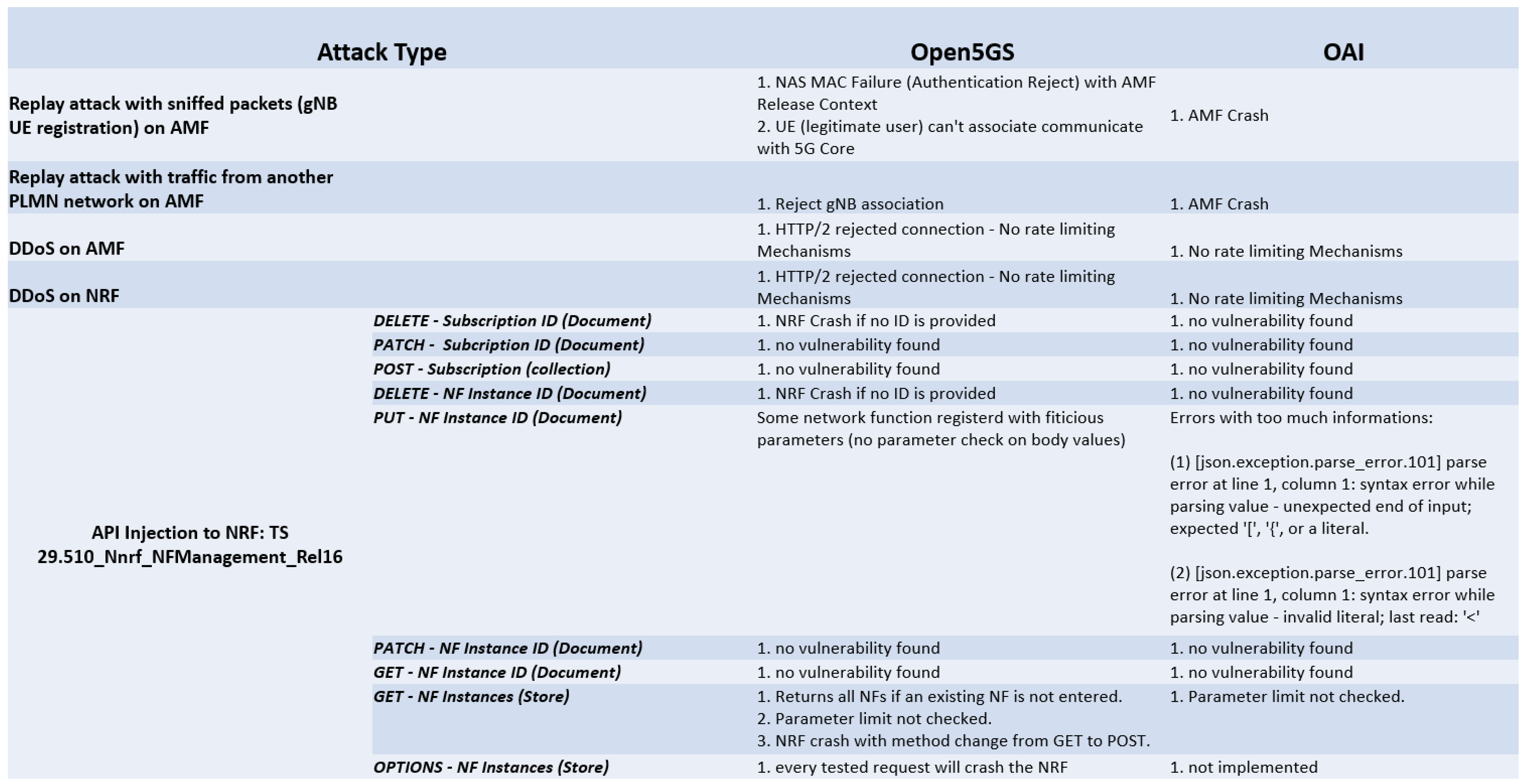A Vulnerability Assessment of Open-Source Implementations of Fifth-Generation Core Network Functions
Abstract
:1. Introduction
1.1. Paper Contribution
1.2. Organization of This Paper
2. Related Work
3. Background on 5G System
3.1. The 5G Architecture
- The Network Exposure Function (NEF) facilitates the exposure of NF functionality externally, fostering interaction with third-party applications.
- AMF orchestrates access control and mobility management.
- The Network Slice Selection Function (NSSF) facilitates the selection of network slices for user-requested services.
- The Session Management Function (SMF) is responsible for session setup and management in alignment with network policies.
- The Policy-Control Function (PCF) provides policy management capabilities.
- UDM stores subscriber data and profiles.
- The NF Repository Function (NRF) enables registration and discovery of NFs for interfunction communication.
- The Authentication Server Function (AUSF) is responsible for user authentication.
3.2. NF Communication Procedures
4. Security in 5G Infrastructure
4.1. Fifth-Generation Protection Mechanisms
General Security Requirements
4.2. Vulnerabilities in 5G System
4.2.1. Insecure API
- Container vulnerabilities: Image vulnerabilities, insufficient isolation, improper configuration, container run-time vulnerabilities;
- Hardware and host vulnerabilities: hardware and software vulnerabilities or improper access control;
- Internal interfaces: API vulnerabilities (within SBI), insecure networking (eavesdropping);
- External interfaces: API vulnerabilities.
4.2.2. DDoS Attacks
4.2.3. Traffic Interception
5. Experimental Methodology
5.1. Testing Methodology
5.2. DoS Attacks (TCP ACK Flooding) on AMF and NFR
5.3. Replay Attack on AMF
5.4. API Injection on NRF
- Parse the API schema definition (OpenAPI 3.0.0) using Burp Suite.
- Initiate an automated scan for each API service in the OAI testbed, injecting malicious parameters/payloads at various junctures of the HTTP requests, including headers, body, and URLs.
- Analyze the scan results for the OAI testbed and export them as an XML file, which serves as the input for the 5GHTTPModifier tool.
- Execute the 5GHTTPModifier tool for each output obtained from the previous scan in the Open5GS testbed.
6. Vulnerability Assessment of AMF and NRF to DoS Attacks
7. Vulnerability Assessment of AMF to Replay Attacks
7.1. Testbed 1—Open5GS
7.2. Testbed 2—OAI
8. Vulnerability Assessment of NRF to API Injection Tests
- OAI Testing Approach: we utilized Burp Suite, which can receive input (via the 5GC API Parse plugin) in the form of a definition file containing the OpenAPI 3.0 schema of the API interfaces, and it delivers requests in the format prescribed by the 3GPP standard. The parameters of Burp Suite were configured to maximize the number of tests performed with the imported API schema, including the activation of the “HTTP smuggler” and “ActiveScan++” extensions to enhance the diversity of tests.
- Open5GS Testing Approach: Starting with the requests that were exported and executed on OAI, we employed the custom tool 5GHTTPModifier. This tool takes as input the path containing all the tests exported from Burp Suite and modifies the parameters, configuring them for the new 5G core. It then sends these requests after transforming them into the HTTP/2 format. Using this tool, we were able to execute identical tests as those performed on OAI, facilitating an objective comparison of the security levels between the two frameworks.
8.1. OAI API Injection Tests
- PUT-NF Instance ID (Document): Not all responses adhere to the standard JSON output format. Errors such as “request method does not exist,” Java Errors, and header errors were observed. In some cases, these errors provided overly informative details, including information about the library and programming language used, which could be valuable to potential attackers.
- OPTIONS-NF Instances (Store): This particular API was found to be unimplemented, as every request simply yielded the response “Do some magic”.
- GET-NF Instances (Store): Requests containing SQL commands within the parameters were not rejected but instead accepted and ignored. Ideally, any requests that deviate from the specifications outlined in the schema should be rejected. For instance, if a parameter is declared as an integer but passed as a string, the entire API request should be rejected. Additionally, it was possible to input any value in optional parameters (such as the “limit” parameter in “nf-instances?nf-type&=”“limit=”), and the API would still return a valid response.
- Response Inconsistencies: Some responses from the API did not conform to the standard JSON output format, revealing errors in request methods and providing excessive information about the implementation, which could be exploited by attackers.
- Lack of Input Sanitization: The APIs lacked proper input sanitization, enabling the acceptance of invalid parameters and SQL commands. This could lead to security vulnerabilities like SQL injection.
- Invalid Method Handling: Inconsistent handling of HTTP methods was observed. For instance, changing the method from GET to POST in certain APIs caused a crash of the NRF, leading to a potential DoS vulnerability.
- Unimplemented APIs: Some API services were not properly implemented and returned generic error messages or “magic” responses.
8.2. Open5GS API Injection Tests
- SQL Injection: Requests containing SQL commands within the parameters are not rejected; instead, they are accepted and ignored. It is unclear whether there is a sanitization process in place. Regardless, all requests that do not conform to the schema specifications should be rejected. For example, if a parameter is declared as an integer but passed as a string, the entire API request should be rejected.
- GET-NF Instance (Store): This API requires two parameters, “NFtype” and “Limit,” but inconsistencies were discovered during testing:
- –
- Any non-existing NF entered in the “NFtype” parameter results in a response with all instances in the core network.
- –
- The “limit” parameter is declared as an integer, but no checks are performed on this parameter, allowing it to contain various data types, including OS/SQL commands or strings.
- –
- Changing the HTTP method from GET to POST in any request to this API causes the NRF to crash, leading to a DoS for the entire Core Network.
- DELETE NF Subscription ID (Document): This API contains an error that causes the network function to crash. Failing to enter any value for the requested parameter leads to the NRF becoming unresponsive.
- DELETE NF Instance ID (Document): Similar to the previous API, this one also has an error that can crash the network function if no value is entered for the requested parameter.
- PUT-NF Instance ID (Document): During some tests, network functions were recorded with dummy parameters, suggesting a potential security flaw.
- OPTIONS-NF Instances (Store): Every request made to this API crashes the NRF.
- Response Inconsistencies: Similar to OAI, some API responses did not adhere to the standard JSON output format, leading to information leakage about the implementation, which could be exploited by attackers.
- Lack of Input Sanitization: Similar to the OAI testbed, Open5GS suffered from insufficient input validation. Requests with SQL commands as parameters were accepted and ignored, potentially leading to security risks.
- Improper Data Handling: During testing, NFs were registered with dummy parameters, highlighting issues in the handling of data inputs.
- Crash on Invalid Inputs: Certain API calls, such as deleting NF subscriptions and instances, could cause the entire core network to crash when provided with invalid inputs.
8.3. General Security Considerations Drawn from API Injection Tests
9. Final Remarks on Security Concerns
- Requests to the NRF can be sent by any machine that can reach it, i.e., there is no authentication token check to verify identity, and thus authorization, to access the network and services. Relying on perimeter security (firewalls and traffic closures) to secure an NF is a weak approach; instead, we must assume a zero-trust design, assuming that anyone can contact the NFs. A DELETE NF Instance by any NF within the core would result in a DoS attack.
- Traffic not encrypted in SBI: in the core 5G, another high-impact issue is the interception of SBA traffic. In both Open5GS and OAI, traffic in the SBI is not encrypted, exposing the core to replay attacks, API injections, and other attacks.
- No rate-limiting on requests to the AMF or NRF: in fact, all requests are answered. This means that no security mechanism is in place to mitigate a DDoS attack, like a SecGW might be.
- No control mechanism (filtering) on user-set values: reliance is placed on client-side filtering when control should also be carried out server-side.
- Replay attacks on N1/N2 interface successfully executed: no security mechanism (sequence number) inserted to counter this attack.
Author Contributions
Funding
Data Availability Statement
Conflicts of Interest
Acronyms
| 5GC | Fifth-Generation Core Network |
| 5G | Fifth-Generation |
| AMF | Access and Mobility Management Function |
| API | Application programming interface |
| CAPIF | Common API Framework |
| CP | Control Plane |
| DDoS | Distributed Denial of Service |
| DN | Data Network |
| EPC | Evolved Packet Core |
| gNB | gNodeB (Next-Generation Node B) |
| GUTI | Globally Unique Temporary ID |
| IMSI | International Mobile Subscriber Identity |
| IoT | Internet of Things |
| IPsec | IP Security |
| MCC | Mobile Country Code |
| MEC | Multiaccess Edge Computing |
| MNC | Mobile Network Code |
| MNO | Mobile Network Operator |
| MSIN | Mobile Subscriber Identification Number |
| N3IWF | Non-3GPP Interworking Function |
| NAS | Non-Access Stratum |
| NEF | Network Exposure Function |
| NF | Network Function |
| NRF | Network Repository Function |
| NSI | Network Specific Identifier |
| OAI | Open-Air Interface |
| RAN | Radio Access Network |
| SBA | Service-Based Architecture |
| SBI | Service-Based Interface |
| SecGW | Security Gateway |
| SEPP | Security Edge Proxy Protection |
| SIM | Subscriber Identity Module |
| SMC | Security Mode Command |
| SMF | Session Management Function |
| SUCI | Subscription Concealed Identifier |
| SUPI | Subscriber Permanent Identifier |
| TLS | Transport Layer Security |
| UE | User Equipment |
| UPF | User Plane Function |
| UP | User Plane |
| WAF | Web Application Firewall |
References
- Witkowski, D. Bridging the Gap: 21st Century Wireless Telecommunications Handbook, 2nd ed.; Independent Publishing Platform: Joint Venture Silicon Valley, CA, USA, 2019. [Google Scholar]
- CISCO. CISCO Annual Internet Report. 2020. Available online: https://www.cisco.com/c/en/us/solutions/collateral/executive-perspectives/annual-internet-report/white-paper-c11-741490.html (accessed on 16 April 2023).
- Open5GS. Available online: https://open5gs.org/ (accessed on 30 September 2023).
- Openairinterface: The Fastest Growing Community and Software Assets in 5g Wireless. Available online: https://openairinterface.org/ (accessed on 30 September 2023).
- Wadatkar, P.V.; Garroppo, R.G.; Nencioni, G. 5G-MEC Testbeds for V2X Applications. Future Internet 2023, 15, 175. [Google Scholar] [CrossRef]
- Dolente, F. Security Analysis of 5G Core Network. Available online: https://github.com/Spartan-F117/VAPT_CoreNetwork5G (accessed on 30 September 2023).
- Nencioni, G.; Garroppo, R.G.; Olimid, R.F. 5G Multi-Access Edge Computing: A Survey on Security, Dependability, and Performance. IEEE Access 2023, 11, 63496–63533. [Google Scholar] [CrossRef]
- Bozorgchenani, A.; Zarakovitis, C.C.; Chien, S.F.; Lim, H.S.; Ni, Q.; Gouglidis, A.; Mallouli, W. Joint Security-vs-QoS Framework: Optimizing the Selection of Intrusion Detection Mechanisms in 5G Networks. In Proceedings of the 17th International Conference on Availability, Reliability and Security, Vienna, Austria, 23–26 August 2022. [Google Scholar] [CrossRef]
- Salazar, Z.; Zaïdi, F.; Nguyen, H.N.; Mallouli, W.; Cavalli, A.; de Oca, E.M. A Network Traffic Mutation Based Ontology, and Its Application to 5G Networks. IEEE Access 2023, 11, 43925–43944. [Google Scholar] [CrossRef]
- Mahyoub, M.; AbdulGhaffar, A.; Alalade, E.; Ndubisi, E.; Matrawy, A. Security Analysis of Critical 5G Interfaces. TechRxiv 2023. [Google Scholar] [CrossRef]
- Park, S.; Kim, D.; Park, Y.; Cho, H.; Kim, D.; Kwon, S. 5G Security Threat Assessment in Real Networks. Sensors 2021, 21, 5524. [Google Scholar] [CrossRef] [PubMed]
- Park, S.; Kwon, S.; Park, Y.; Kim, D.; You, I. Session Management for Security Systems in 5G Standalone Network. IEEE Access 2022, 10, 73421–73436. [Google Scholar] [CrossRef]
- Basin, D.; Dreier, J.; Hirschi, L.; Radomirovic, S.; Sasse, R.; Stettler, V. A Formal Analysis of 5G Authentication. In Proceedings of the 2018 ACM SIGSAC Conference on Computer and Communications Security, Toronto, ON, Canada, 15–19 October 2018; CCS ’18. pp. 1383–1396. [Google Scholar] [CrossRef]
- Hussain, S.R.; Echeverria, M.; Karim, I.; Chowdhury, O.; Bertino, E. 5GReasoner: A Property-Directed Security and Privacy Analysis Framework for 5G Cellular Network Protocol. In Proceedings of the 2019 ACM SIGSAC Conference on Computer and Communications Security, London, UK, 11–15 November 2019; CCS ’19. pp. 669–684. [Google Scholar] [CrossRef]
- Yang, T.; Wang, S.; Zhan, B.; Zhan, N.; Li, J.; Xiang, S.; Xiang, Z.; Mao, B. Formal Analysis of 5G Authentication and Key Management for Applications (AKMA). J. Syst. Archit. 2022, 126, 102478. [Google Scholar] [CrossRef]
- Akon, M.; Yang, T.; Dong, Y.; Hussain, S.R. Formal Analysis of Access Control Mechanism of 5G Core Network. In Proceedings of the 2023 ACM SIGSAC Conference on Computer and Communications Security, Melbourne Australia, 10–14 July 2023; CCS ’23. pp. 666–680. [Google Scholar] [CrossRef]
- Group, N.C.C. The Challenges of Fuzzing 5G Protocols. 5G Secur. Smart Environ. 2021. Available online: https://research.nccgroup.com/2021/10/11/the-challenges-of-fuzzing-5g-protocols/ (accessed on 5 October 2023).
- Salazar, Z.; Nguyen, H.N.; Mallouli, W.; Cavalli, A.R.; Montes de Oca, E. 5Greplay: A 5G Network Traffic Fuzzer—Application to Attack Injection. In Proceedings of the 16th International Conference on Availability, Reliability and Security, Vienna, Austria, 17–20 August 2021. ARES ’21. [Google Scholar] [CrossRef]
- 5GReplay. Available online: https://5greplay.org/docs.html (accessed on 30 September 2023).
- Dumitru-Guzu, O.M.; Vlădeanu, C. Analysis of Potential Threats in NextGen 5G Core. In Proceedings of the 2022 International Symposium on Electronics and Telecommunications (ISETC), Timisoara, Romania, 10–11 November 2022; pp. 1–4. [Google Scholar] [CrossRef]
- 3GPP. TS 23.501 V16.4.0; System Architecture for the 5G System (5GS); Stage 2 (Release 16); ETSI: Sophia Antipolis, France, 2020. [Google Scholar]
- ETSI. TS 129 501 V16.4.0 Principles and Guidelines for Services Definition; Technical Report; ETSI TS 129 501 Version 16.4.0; European Telecommunications Standards Institute (ETSI): Sophia Antipolis, France, 2020. [Google Scholar]
- Swagger. OpenAPI Specification Version 3.0.3. Available online: https://swagger.io/specification/v3/ (accessed on 30 September 2023).
- 3GPP. OpenAPIs for the Service-Based Architecture. Available online: https://www.3gpp.org/technologies/openapis-for-the-service-based-architecture (accessed on 30 September 2023).
- OAuth 2.0. Available online: https://oauth.net/2/ (accessed on 30 September 2023).
- Polese, M.; Bonati, L.; D’Oro, S.; Basagni, S.; Melodia, T. Understanding O-RAN: Architecture, Interfaces, Algorithms, Security, and Research Challenges. IEEE Commun. Surv. Tutor. 2023, 25, 1376–1411. [Google Scholar] [CrossRef]
- Nair, P. Securing 5G and Evolving Architectures; ADDISON WESLEY Publishing Company Incorporated: Boston, MA, USA, 2021. [Google Scholar]
- ETSI. TS 133 501—V17.8.0—5G; Security Architecture and Procedures for 5G System; Technical Report; 3GPP TS 33.501 Version 17.8.0 Release 17; ETSI: Sophia Antipolis, France, 2022. [Google Scholar]
- Akash Tripathi, A.J.W. 5G Network Security Threats and 3GPP Security Mechanisms. Available online: https://techblog.comsoc.org/2022/01/01/5g-network-security-threats-and-3gpp-security-mechanisms/ (accessed on 23 January 2023).
- Palamà, I.; Gringoli, F.; Bianchi, G.; Blefari-Melazzi, N. IMSI Catchers in the wild: A real world 4G/5G assessment. Comput. Netw. 2021, 194, 108137. [Google Scholar] [CrossRef]
- Chlosta, M.; Rupprecht, D.; Pöpper, C.; Holz, T. 5G SUCI-Catchers: Still Catching Them All? In Proceedings of the 14th ACM Conference on Security and Privacy in Wireless and Mobile Networks, Virtual Event, 28 June–2 July 2021; WiSec ’21. pp. 359–364. [Google Scholar] [CrossRef]
- Nie, S.; Zhang, Y.; Wan, T.; Duan, H.; Li, S. Measuring the Deployment of 5G Security Enhancement. In Proceedings of the 15th ACM Conference on Security and Privacy in Wireless and Mobile Networks, San Antonio, TX, USA, 16–19 May 2022; WiSec ’22. pp. 169–174. [Google Scholar] [CrossRef]
- Lasierra, O.; Garcia-Aviles, G.; Municio, E.; Skarmeta, A.F.; Costa-Pérez, X. European 5G Security in the Wild: Reality versus Expectations. In Proceedings of the 16th ACM Conference on Security and Privacy in Wireless and Mobile Networks, WiSec 2023, Guildford, UK, 29 May–1 June 2023; Boureanu, I., Schneider, S., Reaves, B., Tippenhauer, N.O., Eds.; ACM: New York, NY, USA, 2023; pp. 13–18. [Google Scholar] [CrossRef]
- 3GPP. 3GPP TS 23.003 V15.11.0, Numbering, Addressing and Identification (Release 15); ETSI: Sophia Antipolis, France, 2021. [Google Scholar]
- Lemes, M.T.; Alberti, A.M.; Both, C.B.; De Oliveira Júnior, A.C.; Cardoso, K.V. A Tutorial on Trusted and Untrusted Non-3GPP Accesses in 5G Systems—First Steps Toward a Unified Communications Infrastructure. IEEE Access 2022, 10, 116662–116685. [Google Scholar] [CrossRef]
- Meneghello, F.; Calore, M.; Zucchetto, D.; Polese, M.; Zanella, A. IoT: Internet of threats? A survey of practical security vulnerabilities in real IoT devices. IEEE Internet Things J. 2019, 6, 8182–8201. [Google Scholar] [CrossRef]
- Abbasi, A.; Wetzels, J.; Holz, T.; Etalle, S. Challenges in designing exploit mitigations for deeply embedded systems. In Proceedings of the 2019 IEEE European Symposium on Security and Privacy (EuroS&P), Stockholm, Sweden, 17–19 June 2019; pp. 31–46. [Google Scholar]
- Molin, A.; Riviš, A.M.; Marinescu, R. Assessing the real impact of open-source components in software systems. IEEE Access 2023, 11, 111226–111237. [Google Scholar] [CrossRef]
- Yun, I.; Min, C.; Si, X.; Jang, Y.; Kim, T.; Naik, M. {APISan}: Sanitizing {API} Usages through Semantic {Cross-Checking}. In Proceedings of the 25th USENIX Security Symposium (USENIX Security 16), Austin, TX, USA, 10–12 August 2016; pp. 363–378. [Google Scholar]
- Keman, H.; Madnick, S.; Pearlson, K. Is Third-Party Software Leaving You Vulnerable to Cyberattacks? Harv. Bus. Rev. 2021. Available online: https://hbr.org/2021/05/is-third-party-software-leaving-you-vulnerable-to-cyberattacks (accessed on 14 December 2023).
- Stradowski, S.; Madeyski, L. Exploring the challenges in software testing of the 5G system at Nokia: A survey. Inf. Softw. Technol. 2023, 153, 107067. [Google Scholar] [CrossRef]
- PortSwigger. Available online: https://portswigger.net/burp/documentation (accessed on 14 September 2023).
- Køien, G.M. On Threats to the 5G Service Based Architecture. Wirel. Pers. Commun. 2021, 119, 97–116. [Google Scholar] [CrossRef]
- Shen, M.; Ye, K.; Liu, X.; Zhu, L.; Kang, J.; Yu, S.; Li, Q.; Xu, K. Machine Learning-Powered Encrypted Network Traffic Analysis: A Comprehensive Survey. IEEE Commun. Surv. Tutor. 2023, 25, 791–824. [Google Scholar] [CrossRef]
- Bousalem, B.; Silva, V.F.; Langar, R.; Cherrier, S. DDoS Attacks Detection and Mitigation in 5G and Beyond Networks: A Deep Learning-based Approach. In Proceedings of the GLOBECOM 2022—2022 IEEE Global Communications Conference, Rio de Janeiro, Brazil, 4–8 December 2022; pp. 1259–1264. [Google Scholar] [CrossRef]
- MatrixTM. MHDDoS—DDoS Attack Script with 56 Methods. Available online: https://github.com/MatrixTM/MHDDoS (accessed on 30 September 2023).
- Burp Suite. Available online: https://portswigger.net/burp (accessed on 30 September 2023).
- 3GPP. 3GPP TS 33.512 V16.6.0; 5G Security Assurance Specification (SCAS); Access and Mobility Management Function (AMF) (Release 16); ETSI: Sophia Antipolis, France, 2021. [Google Scholar]
- Hu, X.; Liu, C.; Liu, S.; You, W.; Li, Y.; Zhao, Y. A systematic analysis method for 5g non-access stratum signalling security. IEEE Access 2019, 7, 125424–125441. [Google Scholar] [CrossRef]





| User Equipment | Air Interface | RAN | MEC | 5G Packet Core | N6 and Roaming |
|---|---|---|---|---|---|
| Malware | MitM | Rouge Nodes | DDoS Attacks | Virtualization Orchestration Vulnerabilities | IoT Core Integration |
| Firmware Hacks | Jamming | Rouge Applications | API Vulnerabilities | Improper Access Control | App Server Vulnerabilities |
| Tampering | Insecure S1, X2 | Side Channel Attacks | Network Slice Vulnerabilities | Application Vulnerabilities | |
| Sensor Susceptibility | Insecure Xx, Xn | NFVi Vulnerabilities | API Vulnerabilities | API Vulnerabilities | |
| NEF Vulnerabilities | |||||
| Roaming Partner | |||||
| DDoS and DoS Attacks |
| OAI | Open5GS | |
|---|---|---|
| Version used | 1.4.0 | v2.4.11-17 |
| Deployment mode supported | VM, Container, Kubernets | VM, Container, Kubernets |
| Protocols supported in SBI | HTTP/1.1 and HTTP/2 | HTTP/2 |
| TLS in SBI | No | No |
| Declared compliance 3GPP standard | Release 16 | Release 16 |
| Different deployment modes supported | Yes, with script | Yes, configuration to be performed manually |
| Configuration needed before run | No | Yes, Configuration on AMF and UPF |
| API Adherence to the 3GPP Rel 16 Standard | Partial | Partial |
| Parameter | Value (comments) |
| method | TCP (Flooding TCP) |
| url | URL to attack (in our case, the IP address of AMF and NRF) |
| threads | 200 (number of threads employed for the attack) |
| duration | Attack duration (set to 500 s) |
| debug | True (to collect information about the incoming requests in the AMF logs) |
| Method | Description | Number of Requests |
|---|---|---|
| DELETE | Subscription ID (Document) | 628 |
| PATCH | Subscription ID (Document) | 630 |
| POST | Subscription (collection) | 2398 |
| DELETE | NF Instance ID (Document) | 628 |
| PUT | NF Instance ID (Document) | 2987 |
| PATCH | NF Instance ID (Document) | 630 |
| GET | NF Instance ID (Document) | 761 |
| GET | NF Instances (Store) | 820 |
| OPTIONS | NF Instances (Store) | 550 |
Disclaimer/Publisher’s Note: The statements, opinions and data contained in all publications are solely those of the individual author(s) and contributor(s) and not of MDPI and/or the editor(s). MDPI and/or the editor(s) disclaim responsibility for any injury to people or property resulting from any ideas, methods, instructions or products referred to in the content. |
© 2023 by the authors. Licensee MDPI, Basel, Switzerland. This article is an open access article distributed under the terms and conditions of the Creative Commons Attribution (CC BY) license (https://creativecommons.org/licenses/by/4.0/).
Share and Cite
Dolente, F.; Garroppo, R.G.; Pagano, M. A Vulnerability Assessment of Open-Source Implementations of Fifth-Generation Core Network Functions. Future Internet 2024, 16, 1. https://doi.org/10.3390/fi16010001
Dolente F, Garroppo RG, Pagano M. A Vulnerability Assessment of Open-Source Implementations of Fifth-Generation Core Network Functions. Future Internet. 2024; 16(1):1. https://doi.org/10.3390/fi16010001
Chicago/Turabian StyleDolente, Filippo, Rosario Giuseppe Garroppo, and Michele Pagano. 2024. "A Vulnerability Assessment of Open-Source Implementations of Fifth-Generation Core Network Functions" Future Internet 16, no. 1: 1. https://doi.org/10.3390/fi16010001
APA StyleDolente, F., Garroppo, R. G., & Pagano, M. (2024). A Vulnerability Assessment of Open-Source Implementations of Fifth-Generation Core Network Functions. Future Internet, 16(1), 1. https://doi.org/10.3390/fi16010001







